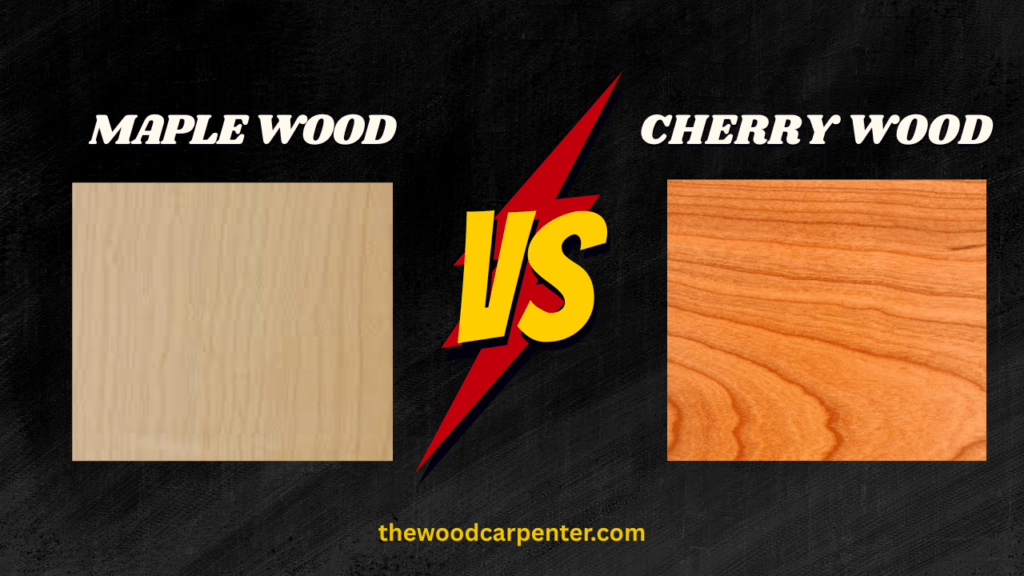
Selecting the ideal wood for your home involves more than aesthetic considerations: durability, maintenance costs, cost effectiveness and compatibility are also critical considerations. Maple and cherry woods are two popular choices that can create beautiful yet useful pieces – but if you find yourself torn between choosing either, know that you are among many who struggle with making this decision!
Both are hardwoods, both look stunning, and both can last for decades if cared for properly. Still, they differ in key ways that might make one a better choice for you than the other.
In this guide, we’ll explore maple vs. cherry wood in detail—covering their appearance, durability, maintenance needs, cost, and best uses—so you can make an informed decision for your furniture or flooring.
Appearance: Light and Airy Maple vs. Rich and Warm Cherry
One of the most obvious differences between cherry and maple wood is their color and grain patterns.
Maple Wood:
Maple has a light, creamy to pale golden color, often with subtle variations across the grain. It adds a clean, open and new look to interiors. Maple planks are usually fairly uniform, so it’s a great option if you’re looking for a continuous look across big furniture pieces or floors.
Cherry Wood:
Cherry Deep reddish tones that naturally darken with age — this wood has a rich patina. This aging process is one of cherry’s best characteristics — it just keeps getting better with age. The fine, creamy grain is sophisticated and warm creating a desirable look for heirloom furniture and focal pieces.
👉 If you prefer light, minimalist spaces, go with maple. If you want warmth and timeless elegance, cherry is your best bet.
Durability: Hard Maple Outshines Softer Cherry
When it comes to hardness and resistance, the two woods aren’t equals.
Maple Wood:
Hard maple scores around 1450 on the Janka hardness scale, which makes it as one of the tougher hardwoods. This means that maple is far more resistant to the scratches, dents, and daily wear, making it ideal for busy households and families with kids, or high-traffic areas like kitchens and living rooms.
Cherry Wood:
Cherry scores around 950 on the Janka scale, which means it’s softer than the maple. Although still considered hardwood, cherry is more susceptible to nicks and dents under heavy use; however it works beautifully in lower trafficked areas like bedrooms, formal dining rooms or accent furniture.
👉 Maple should be chosen if strength and toughness are key considerations; cherry will suit those valuing style over durability.
Workability & Finishing: Easy Cherry vs. Challenging Maple
Maple has a fine, tight grain pattern which makes it challenging to apply stain evenly, leading to uneven absorption and potentially uneven finishes if applied improperly by amateurs or nonprofessionals alike. On the flip side, its fine texture makes for an appealing modern natural aesthetic finish.
Cherry wood is easy to stain and finish. It accepts stain evenly with no uneven graining, though many prefer letting its natural hue deepen over time as its darkness deepens gracefully.
👉 Cherry wood is more suitable for DIY staining projects while maple may appear cleaner when applied with contemporary natural finishes.
Maintenance: Light Maple vs. Dark Cherry
Both woods require regular care in terms of standard cleaning practices–sweeping, dusting, and an occasional buffing – but there’s a subtle distinction:
Maple’s light color hides the dust and it’s dirt better, meaning it looks cleaner between sweeps.
Cherry’s darker tones tend to show lighter debris, dust, or pet hair more easily, which might mean more frequent cleaning if you like spotless surfaces.
👉 If you prefer lower maintenance needs, maple may provide an ideal solution.
Cost: Maple Is More Budget-Friendly
Given variations in price by region and grade, here’s the general rule:
Maple tends to be more affordable and widely available, making it a practical option if you’re furnishing or flooring an entire home.
Cherry is more expensive due to its beauty, aging qualities, and limited supply. It is frequently selected for more luxurious furniture or statement pieces, where looks help justify price.
👉 If you’re watching your wallet, use maple. If you are investing in elegance, cherry is a worthwhile investment.
Maple vs. Cherry for Furniture

Maple Furniture: Strong and resistant to the dents and they are perfect for dining tables, chairs, dressers, and kids’ furniture. Its lighter tone works well in the modern, minimalist, or Scandinavian interiors.
Cherry Furniture: It is est for high-end or heirloom-quality pieces. Think bedroom sets, formal dining tables, and cabinetry where its warmth and patina can shine.
Maple vs. Cherry for Flooring

Maple Flooring: It is great for high-traffic rooms, entryways, and kitchens. It provides a clean, bright look and it resists wear. However, staining the maple can be tricky.
Cherry Flooring: A stunning choice for the formal living rooms or bedrooms. While softer, its deepening color over time adds a character and a warmth that maple can’t replicate.
Sustainability & Longevity
Both woods are sustainable North American hardwoods in their responsible sourcing. With proper care:
Maple floors or furniture can last decades without major wear.
Cherry pieces can become family heirlooms, treasured not just for durability but for the way their beauty evolves with age.
Final Verdict: Maple vs. Cherry Wood
So, which is the right one to go with — maple or cherry?
Choose maple if you’re looking for: durability, good value, a light and modern appearance, and furniture that can withstand heavy use.
Choose cherry if you are: mold-resistant, lover of classic beauty, warmth and luxury finishes.The investment in the suppleness of a beautiful wood will be worth it.
In most homes, the right answer is a mixture; maple in wood flooring or for everyday furniture items, cherry in accent pieces or heirloom-quality crafted objects.
FAQs on Maple vs. Cherry Wood
1. Is maple more durable than cherry?
Yes. Hard maple is significantly harder than the cherry, which makes it more resistant to scratches and dents.
2. Does cherry wood really darken over time?
Absolutely. Cherry also matures to a deepened color with the patina that develops as it’s exposed to light, enhancing its character.
3. Is maple or cherry better for flooring?
Maple is better for high-traffic areas due to its hardness. Cherry is good for low-traffic, fancy rooms.
4. Which wood is more expensive, maple or cherry?
Cherry is usually costlier than some other woods due to its beautiful color and aging properties. Maple is more budget-friendly.
5. Can maple and cherry be stained?
Yes, though maple is difficult to stain evenly because of its tight grain while cherry absorbs stain more easily.

